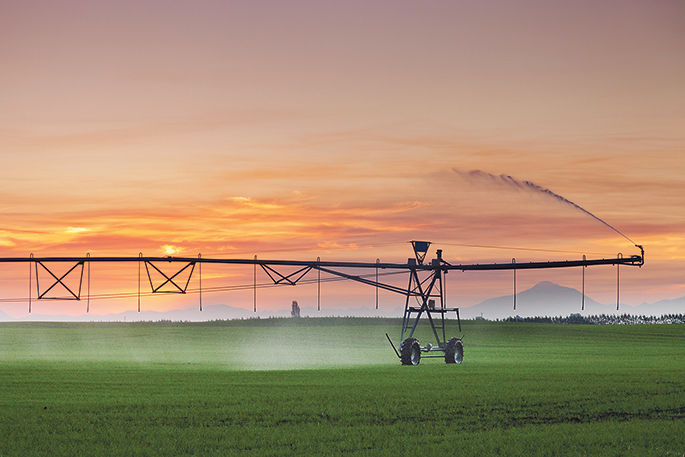IrrigationNZ says a new study by Aqualinc and the Fertiliser Association of New Zealand on how irrigation can be adapted to reduce nitrogen losses could help farmers and growers significantly reduce their environmental impacts.
The study shows on 12 Canterbury dairy farms, an average of a 27 per cent reduction in nitrogen losses could be achieved through changing when irrigation was applied on the farms.
The desktop study was led by Aqualinc Research Ltd’s director research and development Dr John Bright and funded by FANZ.
Using computer models, including Overseer, researchers investigated the effects of different irrigation management rules on pasture production and nitrogen leaching.
They also experimented with a different approach than the current practice of irrigating if the soil moisture content drops below 50 per cent of its plant available water.
“We looked at lower irrigation trigger points to see if they provided any benefits,” says John. “This meant the soil was allowed to dry out more than usual. We also looked at different irrigation targets – varying the soil moisture content we aim to achieve through irrigation.
“We looked specifically at targets that left quite a bit of capacity in the soil to store rainfall should it occur shortly after the irrigation finished.
“We found that filling it up to 80 per cent of plant-available water capacity and leaving 20 per cent for rainfall was probably the best target level from the point of view of reducing the nitrate leaching substantially, while avoiding pasture production losses.”
Trigger level
John’s “pleasantly surprised” by the results. “Before we started the project we didn’t know what the impact would be on pasture production, but this was not compromised.
“We were even more surprised by the consequences of changing the trigger level. We found we could use a much lower soil moisture trigger value in spring and in autumn without having any significant effects on pasture production. This was critical as it allowed the soil to dry out more by delaying irrigation and increased its capacity to store rainfall.”
The research team also deliberately tested target levels that did cause a reduction in pasture production to gauge limits for irrigation triggers and targets. Applying the principles of adjusting trigger levels during the season and using an 80 per cent irrigation target requires the appropriate irrigation system.
“It is essential to have a system that can be adjusted to relatively small application levels, with a short return period. Centre pivots and solid set sprinkler systems were found to be the most suitable irrigation methods. These could most easily be operated using the irrigation rules developed through the research,” says John.
Other benefits include reducing irrigation water use through improved efficiency and making more effective use of rainfall when it occurs.
“For some farmers, it may be possible to achieve some or all of these reductions simply by changing the way they manage their irrigation system,” says John.
IrrigationNZ chief executive Andrew Curtis says farmers and growers who use irrigation want to see improvements to waterways and environment and are working to achieve this.
“Most irrigators now have challenging targets in their Farm Environment Plans to reduce their nitrogen losses.
“The study has helped clarify when the most gains can be made in reducing nitrogen losses through irrigation management,” says Andrew.
Nitrogen losses
“The message for farmers from the study is how you manage your irrigation in early-spring and autumn has a big impact on your overall nitrogen losses. In wetter, cooler conditions there is more risk of nitrogen leaching through soils as pasture growth is slower, so you need to adjust your irrigation as result of this.”
Andrew says based on the study results, farmers should look at not irrigating in September or April, because nutrient losses may outweigh the benefits of some additional pasture growth.
In October and March, he recommends not irrigating as often as in the height of summer and allowing soil moisture levels to drop to around 40 per cent – lower than the 50 per cent level recommended in summer.
“This approach would work in most years, unless very dry conditions occur,” says Andrew.
“Given that significant reductions in nitrogen losses can be made through irrigation management, we’d like to see further research undertaken on how to adjust irrigation for different annual climate conditions.
“Overseer modelling simulates conditions in an average year, but we know that variations in rainfall and temperature affect growing conditions and irrigation use every year.”
Andrew says the study provides supporting evidence on the value of altering irrigation patterns in the shoulder season and the reduction in nutrient losses this can achieve.
“Careful management of irrigation systems can make a big difference to a farm’s environmental footprint. There are a lot of things to be considered – understanding irrigation system capability and requirements, crop and pasture requirements, long-term and short-term weather forecasts, soil moisture monitoring and how to appropriately schedule irrigation.”
The Aqualinc and FANZ study ‘Reducing Nutrient Losses through Improving Irrigation Efficiency’ is available online.



0 Comments
Leave a Comment